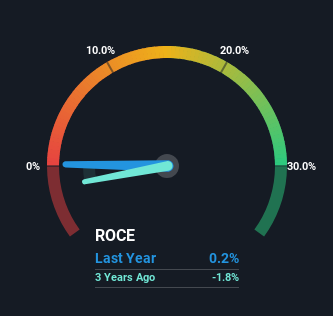- Switzerland
- /
- Machinery
- /
- SWX:PEDU
Perrot Duval Holding's (VTX:PEDU) Returns On Capital Not Reflecting Well On The Business

Ignoring the stock price of a company, what are the underlying trends that tell us a business is past the growth phase? More often than not, we'll see a declining return on capital employed (ROCE) and a declining amount of capital employed. Ultimately this means that the company is earning less per dollar invested and on top of that, it's shrinking its base of capital employed. Having said that, after a brief look, Perrot Duval Holding (VTX:PEDU) we aren't filled with optimism, but let's investigate further.
Return On Capital Employed (ROCE): What Is It?
For those who don't know, ROCE is a measure of a company's yearly pre-tax profit (its return), relative to the capital employed in the business. To calculate this metric for Perrot Duval Holding, this is the formula:
Return on Capital Employed = Earnings Before Interest and Tax (EBIT) ÷ (Total Assets - Current Liabilities)
0.0016 = CHF18k ÷ (CHF15m - CHF3.6m) (Based on the trailing twelve months to October 2024).
Thus, Perrot Duval Holding has an ROCE of 0.2%. In absolute terms, that's a low return and it also under-performs the Machinery industry average of 15%.
Check out our latest analysis for Perrot Duval Holding

Historical performance is a great place to start when researching a stock so above you can see the gauge for Perrot Duval Holding's ROCE against it's prior returns. If you're interested in investigating Perrot Duval Holding's past further, check out this free graph covering Perrot Duval Holding's past earnings, revenue and cash flow.
The Trend Of ROCE
There is reason to be cautious about Perrot Duval Holding, given the returns are trending downwards. Unfortunately the returns on capital have diminished from the 17% that they were earning five years ago. On top of that, it's worth noting that the amount of capital employed within the business has remained relatively steady. This combination can be indicative of a mature business that still has areas to deploy capital, but the returns received aren't as high due potentially to new competition or smaller margins. So because these trends aren't typically conducive to creating a multi-bagger, we wouldn't hold our breath on Perrot Duval Holding becoming one if things continue as they have.
On a side note, Perrot Duval Holding has done well to pay down its current liabilities to 24% of total assets. So we could link some of this to the decrease in ROCE. What's more, this can reduce some aspects of risk to the business because now the company's suppliers or short-term creditors are funding less of its operations. Some would claim this reduces the business' efficiency at generating ROCE since it is now funding more of the operations with its own money.
In Conclusion...
In the end, the trend of lower returns on the same amount of capital isn't typically an indication that we're looking at a growth stock. It should come as no surprise then that the stock has fallen 41% over the last five years, so it looks like investors are recognizing these changes. That being the case, unless the underlying trends revert to a more positive trajectory, we'd consider looking elsewhere.
Since virtually every company faces some risks, it's worth knowing what they are, and we've spotted 3 warning signs for Perrot Duval Holding (of which 2 don't sit too well with us!) that you should know about.
While Perrot Duval Holding may not currently earn the highest returns, we've compiled a list of companies that currently earn more than 25% return on equity. Check out this free list here.
New: Manage All Your Stock Portfolios in One Place
We've created the ultimate portfolio companion for stock investors, and it's free.
• Connect an unlimited number of Portfolios and see your total in one currency
• Be alerted to new Warning Signs or Risks via email or mobile
• Track the Fair Value of your stocks
Have feedback on this article? Concerned about the content? Get in touch with us directly. Alternatively, email editorial-team (at) simplywallst.com.
This article by Simply Wall St is general in nature. We provide commentary based on historical data and analyst forecasts only using an unbiased methodology and our articles are not intended to be financial advice. It does not constitute a recommendation to buy or sell any stock, and does not take account of your objectives, or your financial situation. We aim to bring you long-term focused analysis driven by fundamental data. Note that our analysis may not factor in the latest price-sensitive company announcements or qualitative material. Simply Wall St has no position in any stocks mentioned.
About SWX:PEDU
Perrot Duval Holding
Provides automation technologies in the fields of process automation and chemical cosmetics worldwide.
Flawless balance sheet slight.
Market Insights
Community Narratives


